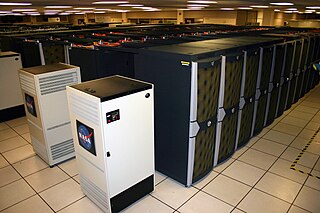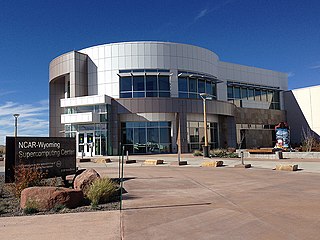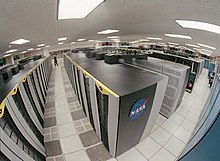
Itanium is a discontinued family of 64-bit Intel microprocessors that implement the Intel Itanium architecture. The Itanium architecture originated at Hewlett-Packard (HP), and was later jointly developed by HP and Intel. Launched in June 2001, Intel initially marketed the processors for enterprise servers and high-performance computing systems. In the concept phase, engineers said "we could run circles around PowerPC...we could kill the x86." Early predictions were that IA-64 would expand to the lower-end servers, supplanting Xeon, and eventually penetrate into the personal computers, eventually to supplant reduced instruction set computing (RISC) and complex instruction set computing (CISC) architectures for all general-purpose applications.

Silicon Graphics, Inc. was an American high-performance computing manufacturer, producing computer hardware and software. Founded in Mountain View, California in November 1981 by James Clark, its initial market was 3D graphics computer workstations, but its products, strategies and market positions developed significantly over time.
Cray Inc., a subsidiary of Hewlett Packard Enterprise, is an American supercomputer manufacturer headquartered in Seattle, Washington. It also manufactures systems for data storage and analytics. Several Cray supercomputer systems are listed in the TOP500, which ranks the most powerful supercomputers in the world.

System X was a supercomputer assembled by Virginia Tech's Advanced Research Computing facility in the summer of 2003. Costing US$5.2 million, it was originally composed of 1,100 Apple Power Mac G5 computers with dual 2.0 GHz processors. System X was decommissioned on May 21, 2012. The supercomputer is also known as Big Mac or Terascale Cluster.

ASCI Red was the first computer built under the Accelerated Strategic Computing Initiative (ASCI), the supercomputing initiative of the United States government created to help the maintenance of the United States nuclear arsenal after the 1992 moratorium on nuclear testing.

Altix is a line of server computers and supercomputers produced by Silicon Graphics, based on Intel processors. It succeeded the MIPS/IRIX-based Origin 3000 servers.

The NASA Advanced Supercomputing (NAS) Division is located at NASA Ames Research Center, Moffett Field in the heart of Silicon Valley in Mountain View, California. It has been the major supercomputing and modeling and simulation resource for NASA missions in aerodynamics, space exploration, studies in weather patterns and ocean currents, and space shuttle and aircraft design and development for almost forty years.

Kalpana was a supercomputer at NASA Ames Research Center operated by the NASA Advanced Supercomputing (NAS) Division and named in honor of astronaut Kalpana Chawla, who was killed in the Space Shuttle Columbia disaster and had worked as an engineer at Ames Research Center prior to joining the Space Shuttle program. It was built in late 2003 and dedicated on May 12, 2004.
The Pittsburgh Supercomputing Center (PSC) is a high performance computing and networking center founded in 1986 and one of the original five NSF Supercomputing Centers. PSC is a joint effort of Carnegie Mellon University and the University of Pittsburgh in Pittsburgh, Pennsylvania, United States.

The TOP500 project ranks and details the 500 most powerful non-distributed computer systems in the world. The project was started in 1993 and publishes an updated list of the supercomputers twice a year. The first of these updates always coincides with the International Supercomputing Conference in June, and the second is presented at the ACM/IEEE Supercomputing Conference in November. The project aims to provide a reliable basis for tracking and detecting trends in high-performance computing and bases rankings on HPL benchmarks, a portable implementation of the high-performance LINPACK benchmark written in Fortran for distributed-memory computers.

Finisterrae was the 100th supercomputer in Top500 ranking in November 2007. Running at 12.97 teraFLOPS, it would rank at position 258 on the list as of June 2008. It is also the third most powerful supercomputer in Spain. It is located in Galicia.

Pleiades is a petascale supercomputer housed at the NASA Advanced Supercomputing (NAS) facility at NASA's Ames Research Center located at Moffett Field near Mountain View, California. It is maintained by NASA and partners Hewlett Packard Enterprise and Intel.
The National Center for Computational Sciences (NCCS) is a United States Department of Energy (DOE) Leadership Computing Facility that houses the Oak Ridge Leadership Computing Facility (OLCF), a DOE Office of Science User Facility charged with helping researchers solve challenging scientific problems of global interest with a combination of leading high-performance computing (HPC) resources and international expertise in scientific computing.

Tianhe-I, Tianhe-1, or TH-1 is a supercomputer capable of an Rmax of 2.5 peta FLOPS. Located at the National Supercomputing Center of Tianjin, China, it was the fastest computer in the world from October 2010 to June 2011 and was one of the few petascale supercomputers in the world.
China operates a number of supercomputer centers which, altogether, hold 29.3% performance share of the world's fastest 500 supercomputers. China's Sunway TaihuLight ranks third in the TOP500 list.

The National Computer Center for Higher Education, based in Montpellier, is a public institution under the supervision of the Ministry of Higher Education and Research (MESR) created by a decree issued in 1999. CINES offers IT services for public research in France. It is one of the major national centers for computing power supply for research in France.

Several centers for supercomputing exist across Europe, and distributed access to them is coordinated by European initiatives to facilitate high-performance computing. One such initiative, the HPC Europa project, fits within the Distributed European Infrastructure for Supercomputing Applications (DEISA), which was formed in 2002 as a consortium of eleven supercomputing centers from seven European countries. Operating within the CORDIS framework, HPC Europa aims to provide access to supercomputers across Europe.

Endeavour is a shared memory supercomputer at the NASA Advanced Supercomputing (NAS) Division at NASA Ames Research Center. It was named after the Space Shuttle Endeavour, the last orbiter built during NASA's Space Shuttle Program.

The NCAR-Wyoming Supercomputing Center (NWSC) is a high-performance computing (HPC) and data archival facility located in Cheyenne, Wyoming, that provides advanced computing services to researchers in the Earth system sciences.
Electra is a petascale supercomputer located at the Ames Research Center facility, manufactured by Hewlett Packard Enterprise in 2016 and commissioned at 2017. This is the first modular supercomputer prototype designed by NASA, as part of its research on making supercomputing more efficient and environment-friendly. Its research resulted in the Aitken supercomputer, destined for Moon landing and related research.














